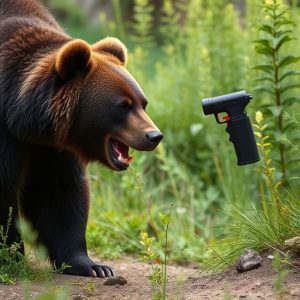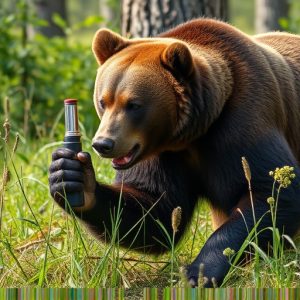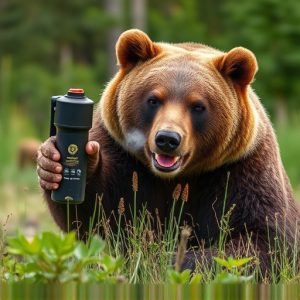Mastering Bear Spray Defense: Ingredients, Choice, and Safety Tips
Bear spray, a vital tool for bear country safety, relies on capsaicin (10% or higher) as its active…….
Bear spray, a vital tool for bear country safety, relies on capsaicin (10% or higher) as its active ingredient to irritate bears' eyes and respiratory systems. Effective concentrations range from 2% to 10%, with higher percentages offering longer protection. Selection should consider environmental threats and optimal 2% capsaicin for balance between deterrence and portability. Proper use involves aiming at the bear's face from 20-30 feet away, wind considerations, regular maintenance, training, local guidelines, and combining with preventive measures.
Bear spray has emerged as a crucial tool for adventurers navigating wild landscapes, offering an effective defense against potential predator encounters. This article delves into the world of bear spray, exploring its science and application. We’ll uncover the active ingredients that make it potent, guide you through choosing the right spray based on percentage for specific needs, and provide essential safety tips for optimal protection in unpredictable environments.
- Understanding Bear Spray: What It Is and How It Works
- The Science Behind Bear Spray Active Ingredients
- Choosing the Right Bear Spray: Percentage Matters
- Effective Use and Safety Tips for Optimal Protection
Understanding Bear Spray: What It Is and How It Works
Bear spray, also known as bear repellent, is a crucial tool for anyone venturing into bear country. It’s a specialized aerosol designed to deter aggressive bears when used correctly. The key to understanding bear spray lies in its active ingredient percentage. Typically, these sprays contain capsaicin, the same compound that makes chili peppers spicy. The concentration can vary, but many quality brands offer 10% or higher capsaicin content, ensuring maximum effectiveness.
When a bear encounters this potent spray, it triggers a strong irritation in their eyes and respiratory system. The spray creates a temporary but powerful barrier, allowing the user to create distance from the predator. This is vital as it gives individuals time to escape or seek shelter, which can significantly improve survival chances during unexpected encounters with bears.
The Science Behind Bear Spray Active Ingredients
The effectiveness of bear spray lies in its active ingredients, carefully formulated to deter aggressive predators. Key components often include capsaicin, the compound responsible for the heat sensation in chili peppers, and other irritants like peppermin or oleoresin capsicum (OC). These compounds target the predator’s sensory systems, specifically their eyes, nose, and respiratory tract, causing temporary but intense discomfort.
The potency of bear spray is measured in percentage of active ingredient, with concentrations typically ranging from 2% to 10%. Higher percentages generally offer a longer duration of protection, allowing users more time to escape potential danger. However, it’s crucial to remember that proper application technique and understanding the spray’s range are equally vital for successful predator deterrence.
Choosing the Right Bear Spray: Percentage Matters
When considering bear spray as a defense mechanism against predators, it’s crucial to understand that not all sprays are created equal. The effectiveness of bear spray heavily relies on its active ingredient percentage. Typically, bear spray contains capsaicin, the same ingredient that makes chili peppers spicy. The concentration can vary widely, from 0.5% to as high as 3%. For optimal protection, opt for a spray with at least 2% capsaicin. This ensures a strong enough peppering effect to deter bears and other predators.
Choosing the right percentage is about balancing effectiveness and portability. Higher concentrations provide better deterrence but make the spray more potent and potentially harsher on the user’s eyes and skin. Lighter concentrations are easier to handle but may not be as impactful. Therefore, understanding your environment and the potential threats you might face is key when selecting a bear spray with the appropriate active ingredient percentage.
Effective Use and Safety Tips for Optimal Protection
Using bear spray effectively requires understanding its active ingredient percentage and safety protocols for optimal protection. The key component in most bear sprays is capsaicin, derived from chili peppers. This substance creates a temporary but powerful irritation in the eyes, nose, and respiratory system of bears, allowing you to retreat safely. When applying bear spray, aim for the bear’s face—eyes, nose, and mouth—from a distance of 20-30 feet (6-9 meters). Ensure the wind is blowing away from you to maximize its effectiveness.
Safety tips include keeping your spray in an easily accessible location, such as on a belt or backpack strap, so you can retrieve it quickly during encounters. Regularly check the expiration date and practice usage with a training spray to familiarize yourself with its range and impact. Always follow local guidelines and regulations regarding bear spray use, as application methods may vary depending on the region and type of wildlife encountered. Remember, prevention is key; carrying bear spray is a tool for safety, but it should complement other precautions like making noise while hiking in bear country and properly storing food to reduce attraction.
Bear spray is a powerful tool for self-defense against predators, with its effectiveness largely dependent on the active ingredient percentage. Understanding the science behind these chemicals and choosing the right bear spray can significantly enhance your safety in wild environments. Always remember to use it responsibly and follow safety tips for optimal protection when encountering potential threats.


